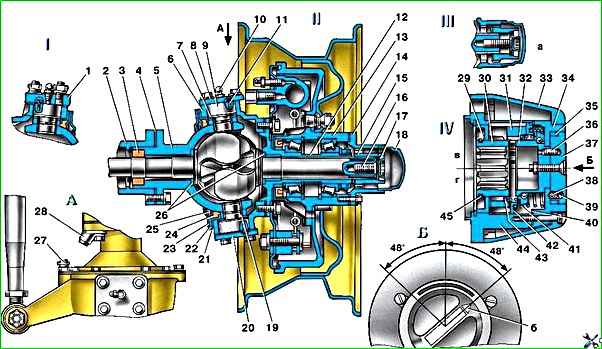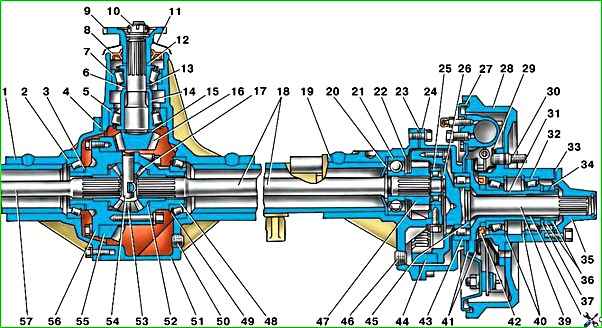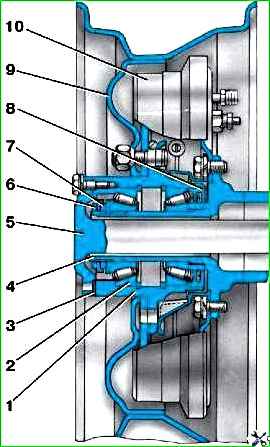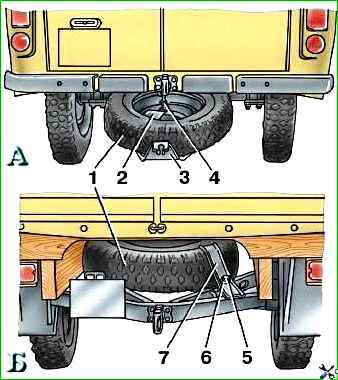The hubs of the front and rear wheels (see Fig. 1 and 3) of all cars, except for cars with final drive axles, are the same
The hub flanges of vehicles with final drive axles (see Fig. 2) are shifted inward by 16.5 mm relative to their outer end and have 10 (instead of 8) threaded holes for the drive flange mounting bolts.
Fig. 1. Steering knuckle: a - signal groove; b - pointer; I - right steering knuckle; II - left steering knuckle; III - wheel release clutch; IV - wheel release clutch (optional); c - wheels are disabled; d - wheels are on; 1 - steering knuckle lever; 2 - axle housing; 3 - oil seal; 4, 20 - gaskets; 5 - ball joint; 6 - steering knuckle body; 7 - support washer; 8 - overlay; 9 - kingpin; 10 - grease fitting; 11 - locking pin; 12 - axle; 13 - wheel hub; 14 - leading flange; 15 - coupling; 16 - coupling bolt; 17 - locking ball; 18 - protective cap; 19 - pin bushing; 21 - inner race; 22 - partition ring; 23 - outer ring; 24 - rubber sealing ring; 25 - felt sealing ring; 26 - thrust washers; 27 - rotation limitation bolt; 28 - wheel rotation limiter; 29 - ring; 30 - drive spline bushing; 31 - connecting spline bushing; 32 - drive bushing; 33 - cap; 34 - cover; 35 - cuff; 36 - pin; 37 - switch; 38 - ball; 39, 41 - springs; 40 - gasket; 42 - driven bushing; 43 - extension spring; 44 - body; 45 - locking ring
Fig. 2. Rear axle with final drive: 1 - final drive housing cover; 2 - differential bearing; 3,13, 49 - shims; 4 - sealing gasket; 5, 7 - drive gear bearings; 6.15 - adjusting rings; 8, 42 - cuffs; 9 - flange; 10 - nut; 11 - dirt deflector; 12 - ring; 14 - spacer sleeve; 16 - main gear drive gear; 17 - satellite; 18 - right axle shaft; 19 - final drive housing; 20, 29 - oil deflectors; 21 - axle bearing; 22, 26, 40 - retaining rings; 23 - sealing gasket of the final drive housing; 24 - final drive housing cover; 25 - bearing; 27 - brake shield: 28 - brake drum; 30 - wheel mounting bolt; 31 - axle; 32 - hub bearing; 33, 41 - gaskets; 34 - lock washer; 35 - leading flange; 36 - hub bearing nut; 37 - lock washer; 38 - bushing; 39 - final drive driven shaft; 43 - driven shaft bearing; 44 - final drive driven gear; 45 - special nut; 46.50 - drain plugs; 47 - final drive drive gear; 48 - right cup of the satellite box; 51 - main gear housing; 52 - axle gear washer; 53 - axle gear; 54 - satellite axis; 55 - driven gear of the main gear; 56 - left cup of the satellite box; 57 - left axle shaft
Fig. 3. Rear wheel hub: 1 - hub; 2 - bearing; 3 - gasket; 4 - axle; 5 - axle shaft; 6 - lock nut; 7 - lock washer; 8 - cuff; 9 - wheel; 10 - brake drum
Car wheels are disk, stamped, with a deep one-piece rim of size 6LX15 or 6JX16 depending on the tires used.
Car tires are pneumatic, tube diagonal (15") or radial (15" or 16").
Fig. 4. Fastening the spare wheel for cars of the UAZ-31512 family: 1 - locking the folding device; 2 - folding bracket; 3 - bolt; 4 - pressure washer; 5 - fixed loop; 6 - axis of the folding bracket; 7, 8 - buffers; 9 - support
Fig. 5. Spare wheel mount: A - UAZ-3741, UAZ-3962, UAZ-2206, UAZ-3909 vehicles; B - cars UAZ-3303, UAZ-33036, UAZ-39094, UAZ-39095: 1 - spare wheel; 2 - sector; 3 - holder; 4 - nut; 5 - bolt; 6 - washer; 7 - spare wheel mounting bracket.
Possible causes of wheel and tire failure
- Cause of malfunction
Removal method nia
Wobbling of the front wheels:
- Large gap in front wheel hub bearings
Adjust the tightness of the wheel hub bearings. If necessary, replace worn or damaged bearings
- Increased clearance in the pin bushings
Adjust or replace worn parts
- Increased clearances in the tie rod joints
Replace worn parts
- Wheel deformation (rim or disk is bent)
If the runout is too large, replace the wheel
Front wheel steering:
- Uneven air pressure in the left and right front tires
Check and, if necessary, adjust the pressure to normal
- Increased clearances in the steering mechanism or in the bipod linkage joints
Adjust or replace worn parts if necessary
- deformation of the front axle housing and frame
Check, straighten bent parts or replace with new ones
- Non-simultaneous action of wheel brake mechanisms
Fix the problem
Increased or uneven tire wear:
- the air pressure in the tires is not normal
Check the pressure and bring it to normal
- Car tire overload
Do not overload the car. Place the load evenly
- Incorrect alignment (steering rod is bent or incorrectly adjusted)
Straighten the rod, adjust its length and check the wheel alignment.
If necessary, replace the rod










